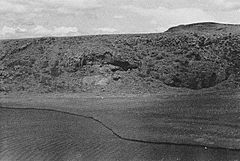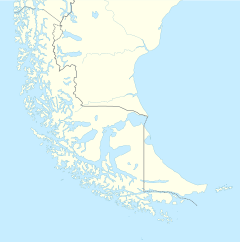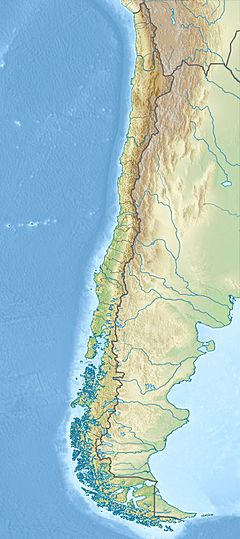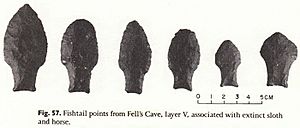Cueva Fell facts for kids

Cueva Fell as seen from across the Chico River
|
|
| Alternative name | Río Chico shelter |
|---|---|
| Location | Chico, Gallegos |
| Region | Patagonia, Chile |
| Coordinates | 52°02′S 70°03′W / 52.033°S 70.050°W |
| History | |
| Founded | Early Holocene, |
| Periods | Neolithic |
| Site notes | |
| Archaeologists | Junius Bird; John Fell |
Cueva Fell is a very old cave and an important archaeological site in southern Patagonia, a region in Chile. It is close to another significant archaeological spot called the Pali Aike Crater. Both Cueva Fell and the Pali Aike site have been suggested to UNESCO as a possible World Heritage Site because they hold so much history about early humans in South America.
Contents
Discovering Cueva Fell
Cueva Fell was found by an explorer named Junius Bird. He noticed the cave because he saw arrow points and stone flakes on the ground nearby. The cave was first called the Río Chico shelter. Later, Bird renamed it Fell's Cave to honor the Fell family. They owned the ranch, Estancia Brazo Norte, where the cave is located. Digging at the site started in 1936.
How the Site Was Formed
Cueva Fell is located in the Río Chico canyon in Chile. This area is near the Straits of Magellan and the Argentine border. It's part of what is known as the Southern Patagonian Basalt Plateaus.
The cave is more like a rock shelter. It formed when river water slowly wore away the sandstone bank. This left behind a roof of hard lava rock, creating a shelter about 28 feet (8.5 meters) deep and 38 feet (11.6 meters) wide. The water also made the floor smooth and hard. Over time, pieces of sandstone fell from the roof. These pieces created a layer of rock that separated different periods of human activity.
Layers of History
Junius Bird carefully labeled the layers of soil and artifacts at the site. He started from the top layer, calling it Layer I. The oldest and deepest layer was called Layer V.
- Surface: This top layer is made of dirt, rocks, and packed sheep manure. It is about 18 to 24 inches (46 to 61 cm) thick.
- Layer I: This is the youngest layer of dark earth, about 10 inches (25 cm) thick. It dates from about 700 years ago to the present day. Scientists believe it dates to around 1265 CE.
- Layer II: This layer is also dark earth and is hard to tell apart from Layer I. It is about 10 inches (25 cm) or more thick. This layer is about 6,500 years old.
- Layer III: This layer is different from Layer II because the earth is more compacted. It is about 12 to 15 inches (30 to 38 cm) thick. It dates from about 8,500 to 6,500 years ago.
- Layer IV: This layer is 13 to 17 inches (33 to 43 cm) thick and made of very packed dark earth. It dates from about 10,000 to 8,500 years ago.
- Sterile Layer: After the oldest human layer (Layer V) formed, large sandstone slabs fell from the cave roof. This sealed off the older layers. This layer is about 15 to 20 inches (38 to 51 cm) thick. It has no human artifacts.
- Layer V: This is the oldest layer where humans lived. It's made of soft clay soil and is 3 to 9 inches (7.6 to 23 cm) thick. This layer dates back to about 11,000 to 10,080 years ago.
Time Periods and Tools
Bird named the time periods from oldest to newest. So, Period I is the oldest and is found in Layer V. Period V is the most recent and is found in Layer I.
- Period V (Layer I): This period has small arrow points and various bone tools. Things like combs and beads were also found. The style of the arrow points suggests they might belong to the Ona Indians. Most of the animal bones found here are from guanacos.
- Period IV (Layer II): This period has stone tools like stemmed (with a handle-like base) stone points, knives, and small scrapers. Bone tools, large bolas (throwing weapons), beads, and other decorations were also found. People in this period also built structures, including graves and rock piles. Again, most of the animal bones are from guanacos.
- Period III (Layer III): In this layer, archaeologists found bone awls (pointed tools), stone scrapers, and triangular stone points with rounded bases. They also found bolas that were much smaller than those from Period IV. These small bolas might have been used to catch birds. Guanaco and fox bones are common here.
- Period II (Layer IV): This layer mainly contains bone points and awls, and stone scrapers. Junius Bird noted that this layer had much more sediment compared to the number of artifacts.
- Period I (Layer V): This is the oldest period of human life at the site, known as the Fell's Tradition. Cueva Fell is the main site for this tradition. This period is known for its unique fishtail points, along with stone scrapers, choppers, stone discs, and bone tools. Several ancient fireplaces were also found in this layer. These fireplaces date back to about 11,000 to 10,000 years ago.
Ancient Environment
Climate Changes
Before about 12,500 years ago, the area around Cueva Fell was very windy and freezing cold all year. It received very little rain. This heathland environment changed to a treeless, dry, grassy steppe by 11,000 years ago. This happened as the freezing temperatures and winds started to lessen. This was the climate just before the first humans lived in the area.
The earliest human presence at Cueva Fell, around 11,000 to 10,000 years ago, happened during a cold period. This time, similar to the Younger Dryas in other parts of the world, saw low temperatures and more rain in Patagonia. Glaciers even grew larger. This period was the end of the last ice age, with a very changing climate. While some animals were affected, humans were already good at adapting to new environments. They seemed to handle the unpredictable climate well.
As the Earth continued to warm, the environment of southern Patagonia kept changing. Evidence from Cueva Fell suggests that summer droughts were common. These droughts, along with more summer storms, might have caused wildfires. Less water and big changes in plant types (seen through pollen analysis) likely contributed to the extinction of many animals.
From 9,000 to 6,000 years ago, the climate shifts were less dramatic. There was a general trend away from dry-loving plants, suggesting more rain. After 6,000 years ago, there isn't enough information from the site to know the exact local climate. However, other regional studies suggest it became a bit drier.
Today, Cueva Fell is in the Fuego-Patagonia steppe environment. This area gets less than 400 mm (15.7 in) of rain each year. It is mostly covered by tough grasses and other plants.
Plants and Animals
Cueva Fell is special because many bones of now-extinct animals were found there. These include the giant sloth and the horse. Horses actually disappeared from the Americas for a long time until Europeans brought them back. The discovery of ancient horse bones at Cueva Fell was the first proof that horses lived in the Americas before Europeans arrived.
The layers of human and animal remains show that people lived in the area before these native horses and giant sloths died out. This evidence also suggests that ancient horses were hunted and eaten. But humans weren't the only hunters. Bones of horses, llamas, and ground sloths show puncture marks, likely from the Patagonia panther.
The extinction of many plant-eating animals in South America during the Early Holocene was first thought to be caused by humans hunting too much. But pollen analysis from Cueva Fell showed a big drop in grasslands in southern Patagonia just before these extinctions. This was early proof that hunting might not have been the only reason for the animals dying out.
Large numbers of guanaco bones were also found in the older layers. While other large grazing animals died out, guanacos survived. This is probably because they could eat a wider variety of plants, adapting to the changes in vegetation as the climate warmed. Guanaco populations did drop at first, but they eventually recovered.
Bones of canine animals were found in all five human layers. At first, scientists thought these were from domestic dogs. This would have been amazing, as it would be the earliest proof of domestic dogs in the Americas. However, later studies suggested the bones were from two wild species: the South American gray fox and Canis avus (a small fox or wolf-like canine unique to South America in the late Pleistocene period). Other animal bones found include hawks and falcons.
Tools and Artifacts
The first dig at Cueva Fell in 1936 found 511 artifacts. These included tools with handles, knives, scrapers, bolas, circular rubbing stones, and bone tools.
| Distribution of artefacts from Fell's Cave (1936) | ||||||||||||||||||||||||||||||||
|---|---|---|---|---|---|---|---|---|---|---|---|---|---|---|---|---|---|---|---|---|---|---|---|---|---|---|---|---|---|---|---|---|
| Group | Category | Surface layer | Layer I | Layer II | Layer III | Layer IV | Layer V | Total | ||||||||||||||||||||||||
| Hafted implements | Ona-type arrow point | - | 13 | 2 | - | - | - | 15 | ||||||||||||||||||||||||
| Patagonian-type arrow point | 1 | 11 | 5 | 1 | - | - | 18 | |||||||||||||||||||||||||
| Small, triangular arrow point | - | 2 | - | 1 | - | - | 3 | |||||||||||||||||||||||||
| Small, rudimentary stem | - | 1 | - | - | - | - | 1 | |||||||||||||||||||||||||
| Old-type, triangular point | - | - | 2 | 20 | 2 | - | 24 | |||||||||||||||||||||||||
| Triangular, concave base | - | 1 | 1 | 2 | - | 1 | 5 | |||||||||||||||||||||||||
| Fishtail point | - | - | - | - | - | 15 | 15 | |||||||||||||||||||||||||
| Hafted knife | - | 12 | 5 | 2 | - | - | 19 | |||||||||||||||||||||||||
| Hafted knife, questionable | - | 5 | 2 | - | - | - | 7 | |||||||||||||||||||||||||
| Knives | Thin, single-edge | - | 1 | - | 2 | - | - | 3 | ||||||||||||||||||||||||
| 3-sided | - | - | possibly 2 | 1 | 1 | - | 4 | |||||||||||||||||||||||||
| ?, concave base, broad, thin | - | - | 1 | - | - | - | 1 | |||||||||||||||||||||||||
| Fragment (uncertain) | - | - | - | - | - | 3 | 3 | |||||||||||||||||||||||||
| Combination knife-scraper | - | - | 1 | 2 | - | - | 3 | |||||||||||||||||||||||||
| Scrapers | Single-edge, rough flake | 11 | 45 | 59 | 36 | 25 | 26 | 202 | ||||||||||||||||||||||||
| 2-edge, large | 3 | 2 | 2 | - | 2 | 1 | 10 | |||||||||||||||||||||||||
| 2-edge, narrow | - | 4 | 11 | 1 | 6 | - | 22 | |||||||||||||||||||||||||
| 2 points | - | - | - | - | - | 2 | 2 | |||||||||||||||||||||||||
| Large, rough, circular edge | - | - | 1 | 2 | 2 | 6 | 11 | |||||||||||||||||||||||||
| Reversed-edge | - | 1 | - | - | - | 1 | 2 | |||||||||||||||||||||||||
| End | - | - | - | - | - | 6 | 6 | |||||||||||||||||||||||||
| Small, hafted | 13 | 26 | 51 | 9 | - | - | 99 | |||||||||||||||||||||||||
| Unfinished blank | - | 1 | - | 6 | 1 | - | 8 | |||||||||||||||||||||||||
| Bolas | Deep groove, flat ends | - | 1 | - | - | - | - | 1 | ||||||||||||||||||||||||
| Unfinished | - | - | - | 1 | - | - | 1 | |||||||||||||||||||||||||
| Spherical, fragment | - | 1 | - | - | - | - | 1 | |||||||||||||||||||||||||
| Lemon-shaped, fragment | - | - | 1 | - | - | - | 1 | |||||||||||||||||||||||||
| Circular rubbing stone | - | - | - | - | - | 2 | 2 | |||||||||||||||||||||||||
| Bone implements | Chipping tool | - | 12 | 6 | - | - | - | 18 | ||||||||||||||||||||||||
| Bird bone awl | - | - | 1 | - | - | - | 1 | |||||||||||||||||||||||||
| Solid bone awl | - | 1 | - | - | - | - | 1 | |||||||||||||||||||||||||
| Lance point | - | - | - | - | 1 | - | 1 | |||||||||||||||||||||||||
| Bead | - | 1 | - | - | - | - | 1 | |||||||||||||||||||||||||
| Totals | 28 | 141 | 153 | 86 | 40 | 63 | 511 | |||||||||||||||||||||||||
The most important discovery from the 1936 dig was the fishtail projectile point. All of these fishtail points were found with bones of large animals. These included extinct horses, giant ground sloths, and guanacos. Fifteen fishtail points were found in Layer V, the oldest layer, dating back to about 11,000 to 10,080 years ago. These points are about 11,000 years old.
Round, flat stones, called circular rubbing stones in the chart, were also found. Junius Bird noted that stone tools shaped by pecking and grinding are rare among very early human finds, so these were special. Two such stones were found, both made from lava and clearly linked to animal remains. The larger one was about 4.8 inches (12.3 cm) across and weighed about 2.5 pounds (1.12 kg). The smaller one was about 3.3 inches (8.4 cm) across and weighed about 1.1 pounds (0.5 kg). Many scrapers were also found throughout all the layers of Cueva Fell. The bone tools found were likely made from sloth bone, as they showed no signs of marrow cavities.
In 1969, a second excavation was done at Cueva Fell, focusing on a slightly different part of the cave. This dig found 415 artifacts, including various points, knives, scrapers, cores, bolas, and bone tools.
| Artefacts from Fell's Cave excavated in 1969 and 1970 | ||||||||||||||||||||||||||||||||
|---|---|---|---|---|---|---|---|---|---|---|---|---|---|---|---|---|---|---|---|---|---|---|---|---|---|---|---|---|---|---|---|---|
| Group | Category | Area D | Area C and D | Total | ||||||||||||||||||||||||||||
| Points | Ona, small, barbed | 9 | - | 9 | ||||||||||||||||||||||||||||
| Small, triangular | 1 | - | 1 | |||||||||||||||||||||||||||||
| Unidentified, fragment | 1 | - | 1 | |||||||||||||||||||||||||||||
| Patagonian, stemmed | 7 | 9 | 16 | |||||||||||||||||||||||||||||
| Spear | 1 | 1 | 2 | |||||||||||||||||||||||||||||
| Old-type, stemless, triangular | - | 16 | 16 | |||||||||||||||||||||||||||||
| Fishtail | - | 1 | 1 | |||||||||||||||||||||||||||||
| Knives | Hafted | 1 | - | 1 | ||||||||||||||||||||||||||||
| Knife or spear | - | 2 | 2 | |||||||||||||||||||||||||||||
| Small, leaf-shaped | - | 1 | 1 | |||||||||||||||||||||||||||||
| Single edge (from flake) | 2 | 3 | 5 | |||||||||||||||||||||||||||||
| 3-edge | - | 2 | 2 | |||||||||||||||||||||||||||||
| Combination knife-scraper | 1 | 2 | 3 | |||||||||||||||||||||||||||||
| Scrapers | Rough, single-edge flake | 26 | 103 | 129 | ||||||||||||||||||||||||||||
| 2-edge, large | 2 | 13 | 15 | |||||||||||||||||||||||||||||
| 2-edge, narrow (parallel) | 1 | 1 | 2 | |||||||||||||||||||||||||||||
| 2 points | 1 | - | 1 | |||||||||||||||||||||||||||||
| 2 sides to point | 1 | 4 | 5 | |||||||||||||||||||||||||||||
| 1-edge (like 2-edge) | 31 | 47 | 78 | |||||||||||||||||||||||||||||
| 1-sided, rounded end | - | 5 | 5 | |||||||||||||||||||||||||||||
| Large, circular | - | 12 | 12 | |||||||||||||||||||||||||||||
| End | 3 | 8 | 11 | |||||||||||||||||||||||||||||
| Reversed 2-edge | 1 | - | 1 | |||||||||||||||||||||||||||||
| Hafted | 32 | 23 | 55 | |||||||||||||||||||||||||||||
| Fragment, uncertain, misc. | 2 | 9 | 11 | |||||||||||||||||||||||||||||
| Blank | - | 9 | 9 | |||||||||||||||||||||||||||||
| Cores | 1 | 4 | 5 | |||||||||||||||||||||||||||||
| Bolas | 1 | 3 | 4 | |||||||||||||||||||||||||||||
| Bone tools | Chipping tool | 2 | 1 | 3 | ||||||||||||||||||||||||||||
| Bird bone awl | - | 3 | 3 | |||||||||||||||||||||||||||||
| Solid point awl | 1 | 1 | 2 | |||||||||||||||||||||||||||||
| Bonce lance point | - | 3 | 3 | |||||||||||||||||||||||||||||
| Spear thrower contact point | - | 1 | 1 | |||||||||||||||||||||||||||||
| Total | 130 | 285 | 415 | |||||||||||||||||||||||||||||
Why Cueva Fell is Important
Cueva Fell is a very important site for several reasons, especially for understanding how humans first spread across the Americas.
The First Americans
How and when people first arrived in the Americas is a big debate among archaeologists. For many years, the "Clovis-first model" was the main idea. This theory said that the Clovis culture were the first people to arrive in North America. They came from Asia across the Bering Land Bridge and moved south through an ice-free path. Then, they spread through Central and South America.
At the time, no archaeological evidence was found in the Americas that was older than the Clovis culture (about 11,050 to 10,800 years ago). However, in recent decades, many sites have been found that are older than Clovis. These new discoveries mean that a new model is needed to explain how the Americas were populated.
Now, many researchers believe that a pre-Clovis culture (meaning, a culture that existed before Clovis) came to the Americas along the Pacific coast. This likely happened between 14,000 and 12,000 years ago.
Some of the evidence for this coastal theory comes from the very southern parts of South America. Many experts agree that humans living in Tierra del Fuego (the "Land of Fire") between 11,000 and 10,500 years ago doesn't leave enough time for them to have migrated all the way from North America through the middle of the continent. A similar argument is made about Monte Verde, another famous site in Chile. Monte Verde is about 1,000 years older than Clovis.
Cueva Fell shows that people lived in southern South America very early. The oldest human activity at Cueva Fell, dating back to about 11,000 to 10,080 years ago, is from the same time as the Clovis culture, not older. Other ancient sites in Argentina, like Cerro Tres Tetas and Piedra Museo, also show human presence at the same time as Clovis and Cueva Fell.
Stone Tool Technology
It used to be common to compare the ancient history of South America with North America. However, this is becoming less common, especially when looking at early tool-making. People once thought that the early fluted points (spear points with a groove) found in South America were just copies of the North American Clovis points.
South American fluted points include the fishtail point found at Cueva Fell and other places. There are also the El Jobo point (from Venezuela) and the Paijan point (from Peru and Ecuador). All of these date to the same time as Clovis.
The different types of fluted stone tools in South America show that people adapted their tools to hunt large animals (megafauna) in their specific regions. This is different from the Clovis points, which were used across all of North America. These regional tool adaptations suggest that small groups of early people spread out across the huge continent. The fishtail points from Cueva Fell are important evidence that shows the differences in tool technology between North and South America.
Finding Sites in Fuego-Patagonia
Cueva Fell is also important because it might represent the earliest human presence in Fuego-Patagonia, around 11,000 years ago. This southern region of South America is like "the end of the line" for the first people who explored the New World.
The early people in Fuego-Patagonia likely lived in small groups spread over large areas. This makes finding their ancient sites very difficult. Also, these very old sites are often buried deep underground. Many of these sites, including Cueva Fell, are rock shelters that have been used by meat-eating animals for thousands of years. These animals can disturb the archaeological layers and make it harder to recognize human sites. Because of these challenges, Junius Bird's discovery of Cueva Fell in 1936 was truly remarkable.
Images for kids
See also
 In Spanish: Cueva Fell para niños
In Spanish: Cueva Fell para niños






